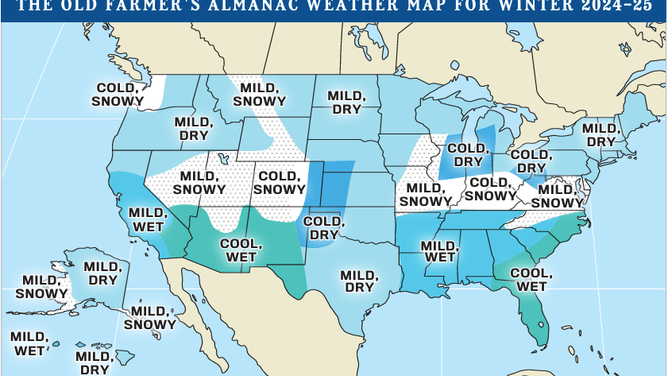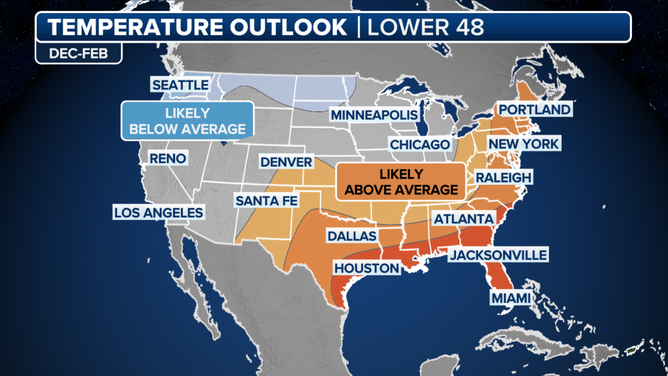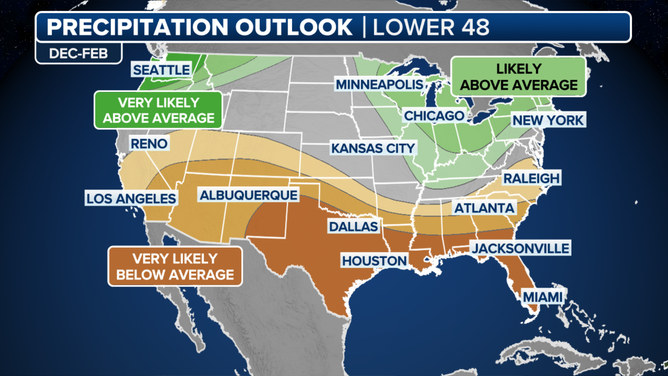Farmers almanacs issue dueling winter outlooks: 'Gentler' or 'whirlwind'?
Both The Old Farmer's Almanac and The Farmers' Almanac boast high accuracy in their forecasts. But this year, they’ve predicted nearly "polar" opposite winters in many spots around the U.S.
Fall outlook shows us what to expect in US this autumn
The official fall weather outlook from NOAA's Climate Prediction Center says most of the U.S. will see a warm, dry autumn.
DUBLIN, N.H. – It’s a farmer's almanac fight!
The Old Farmer's Almanac, established in 1792 in New Hampshire, released its new winter outlook this week. It comes just two weeks after The Farmers' Almanac, established in 1818 in Maine, unleashed its own winter outlook.
Both boast high accuracy in their forecasts. But this year, they’ve predicted nearly "polar" opposite winters in many spots around the U.S.
The Old Farmer's Almanac has headlined its outlook as a "'Calmer, Gentler' Winter," while its counterpart instead predicts a "Wet Winter Whirlwind."
Old Farmer's Almanac: ‘Temperate, uneventful winter’?
The Old Farmer's Almanac says its centuries-old formula for predicting the winter uses a mix of solar science and the study of sunspots, climatology and meteorology.
"This winter, temperatures will be up and snowfall down throughout most of the United States," Carol Connare, the Old Farmer's Almanac's editor-in-chief, wrote in a news release announcing its winter prognostication. "While there will still be plenty of chilly temperatures and snow for most slopes, the high heating costs associated with the season shouldn’t hit so hard. We’re predicting a temperate, uneventful winter – potentially a welcome reprieve from the extremes of recent years."

The Old Farmer's Almanac Winter Outlook for 2024-25
(The Old Farmer's Almanac)
It's especially true in the interior Northeast where it predicts a "gentler-than-normal season" that’s "not so rough and tough." For the populous Interstate 95 corridor from Washington to Boston, snowfall is predicted to be below average in the North but above average in the South, with the coldest temperatures in early and late January and late February.
One winter conundrum: the Super Bowl, set for New Orleans in early February. The Old Farmer's Almanac predicts a cold snap is in the cards from late January into early February, tumbling out of the northern Plains, spreading across the Deep South and into the Southeast, which could affect travel for fans.
Overall, frequent winter rainstorms are predicted in Florida, the Deep South and California, leaving those regions "soaked," the almanac says.
TALE OF THE TAPE: OLD FARMER'S ALMANAC | THE FARMERS' ALMANAC | NOAA
Or, perhaps a ‘whirlwind’ instead?
Au contraire, says The Farmer's Almanac.
Its keepers are a bit more coy about their forecasting methods, touting a "proprietary weather prediction formula" that "adapts to the mysteries of nature." But it says its forecast does incorporate some anticipated effects of La Niña, which is predicted to develop this autumn and hang on through the 2024-25 winter season.
Overall, The Farmer's Almanac is more bullish on the winter with its annual extended weather prediction calling for a season of rapid-fire storms that will bring both rain and snow.

The Farmers' Almanac Winter Outlook for 2024-25
(The Farmers' Almanac / FOX Weather)
Its outlook shows a very active storm track that will deliver frequent bouts of heavy precipitation and strong and gusty winds over most of the eastern half of the country.
For the Northeast, where the Old Farmer's Almanac predicts mild and dry, The Farmers' Almanac predicts it will be stormy with above-average amounts of winter precipitation and near- to above-average temperatures. It also predicts the heaviest snow will fall over the interior and mountainous areas, while the coast will see sleet and rain – especially near and along the Interstate 95 corridor.
And in contrast to the Old Farmer's Almanac, The Farmers' Almanac predicts a cold overall winter for the northern Plains, while its counterpart is going with "mild and dry." They differ on the Great Lakes as well, with The Farmer's Almanac going with a snowy winter while the Old Farmer's Almanac is predicting a drier winter.
They both agree on a few things: There will be a chilly and wet winter in the Pacific Northwest and, on average, a mild and wet winter in the Deep South and Southeast. The Farmer's Almanac is also on board predicting wintry storms across much of the U.S. in late January and early February.
What does NOAA say?
While NOAA doesn't attempt to predict specific periods in winter when the weather might be particularly eventful, as both almanacs do, it does issue seasonal outlooks for successive three-month periods.

NOAA winter outlook.
(FOX Weather)
Peeking at its outlook that covers December, January and February, it is leaning more toward the idea of an overall mild winter across the South and East, limiting forecasts for a colder, wetter winter to the Pacific Northwest (three-for-three!) into the northern Plains.

NOAA winter precipitation outlook.
(FOX Weather)
NOAA’s outlook has a heavy La Niña influence, whose winters tend to be cooler and wetter across the North and milder and drier across the South.
We'll see come next spring which forecast "rained" supreme!
